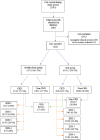Is proteinuria a rare condition in apparently healthy and sick cats? A feline practice experience (2007-2018)
- PMID: 34722216
- PMCID: PMC8541710
- DOI: 10.5455/OVJ.2021.v11.i3.24
Is proteinuria a rare condition in apparently healthy and sick cats? A feline practice experience (2007-2018)
Abstract
Background: Proteinuria is assumed to be less frequent in cats than in dogs and is mainly associated with chronic kidney disease (CKD).
Aim: The current study aimed to evaluate and compare urine protein-to-creatinine (UPC) values retrospectively in cats visited for comprehensive annual health check or for presenting systemic clinical signs related to CKD.
Methods: UPC ratio was retrospectively evaluated in 112 owned cats, out of which 51 (45.5%) were apparently healthy cats according to their owners who visited for comprehensive annual health checks and 61 (54.5%) sick cats, presenting systemic clinical signs suggesting CKD, such as weight loss or polyuria/polydipsia, among others.
Results: Based on UPC, the present study found that 54.5% of all cats included were borderline proteinuric or proteinuric, having increased UPC (UPC ≥ 0.2), with 35.7% included in the sick group and 18.7% in the health-check group. Increased UPC was also statistically associated with azotemia and isosthenuria (urinary-specific gravity between 1,008 and 1,035) in both sick and health-check groups of cats.
Conclusion: Independent of the reason for their medical visit, it could be concluded that borderline proteinuria and proteinuria were statistically mainly related to CKD in cats. Furthermore, the measurement of UPC could be very useful in the detection and management of CKD in apparently healthy cats during a medical visit for annual health check irrespective of the age.
Keywords: Annual health check; Kidney; UPC; Urinalysis; Urine protein-to-creatinine ratio.
Conflict of interest statement
The authors declared no potential conflicts of interest with respect to the research, authorship, and/or publication of this article.
Figures
Similar articles
-
Biological variation of urinary protein: Creatinine ratio and urine specific gravity in cats.J Vet Intern Med. 2023 Nov-Dec;37(6):2261-2268. doi: 10.1111/jvim.16881. Epub 2023 Oct 12. J Vet Intern Med. 2023. PMID: 37828720 Free PMC article.
-
Comparison of cystocentesis versus home sampling to determine urinary protein: Creatinine ratio and urine specific gravity in cats.J Vet Intern Med. 2023 Jul-Aug;37(4):1401-1408. doi: 10.1111/jvim.16800. Epub 2023 Jun 30. J Vet Intern Med. 2023. PMID: 37387324 Free PMC article.
-
Clinical importance of borderline proteinuria in nonazotemic cats and evaluation of other risk factors for the development of chronic kidney disease.J Vet Intern Med. 2025 Jan-Feb;39(1):e17257. doi: 10.1111/jvim.17257. J Vet Intern Med. 2025. PMID: 39696777 Free PMC article.
-
Measurement, interpretation, and implications of proteinuria and albuminuria.Vet Clin North Am Small Anim Pract. 2007 Mar;37(2):283-95, vi-vii. doi: 10.1016/j.cvsm.2006.11.003. Vet Clin North Am Small Anim Pract. 2007. PMID: 17336676 Review.
-
Proteinuria in dogs and cats.Can Vet J. 2012 Jun;53(6):631-8. Can Vet J. 2012. PMID: 23204582 Free PMC article. Review.
Cited by
-
Urinary Protein/Creatinine Ratio in Feline Medicine: Reasons to Perform It and Its Role in Clinical Practice-A Retrospective Study.Animals (Basel). 2022 Jun 18;12(12):1575. doi: 10.3390/ani12121575. Animals (Basel). 2022. PMID: 35739913 Free PMC article.
-
Proteinuria and Electrophoretic Pattern in Dogs with Comorbidities Associated with Chronic Kidney Disease.Animals (Basel). 2023 Apr 19;13(8):1399. doi: 10.3390/ani13081399. Animals (Basel). 2023. PMID: 37106962 Free PMC article.
-
Longitudinal Study of Renal Health Screening in Apparently Healthy Aging Dogs.J Vet Intern Med. 2025 May-Jun;39(3):e70116. doi: 10.1111/jvim.70116. J Vet Intern Med. 2025. PMID: 40317952 Free PMC article.
-
Urinary Electrophoretograms Performed by Capillary Electrophoresis: Comparison between Dogs and Cats.Gels. 2023 Jul 4;9(7):544. doi: 10.3390/gels9070544. Gels. 2023. PMID: 37504423 Free PMC article.
-
Review and statistical analysis of clinical management of feline leishmaniosis caused by Leishmania infantum.Parasit Vectors. 2022 Jul 11;15(1):253. doi: 10.1186/s13071-022-05369-6. Parasit Vectors. 2022. PMID: 35818075 Free PMC article. Review.
References
-
- Al-Ghazlat S.A, Langston C.E, Greco D.S, Reine N.J, May S.N, Shofer F.S. The prevalence of microalbuminuria and proteinuria in cats with diabetes mellitus. Top. Companion Anim. Med. 2011;26:154–157. - PubMed
-
- Bartges J.W. Chronic kidney disease in dogs and cats. Vet. Clin. North Am. Small Anim. Pract. 2012;42:669–692. - PubMed
-
- Brown C.A, Elliott J, Schmiedt C.W, Brown S.A. Chronic kidney disease in aged cats: clinical features, morphology, and proposed pathogeneses. Vet. Pathol. 2016;53:309–326. - PubMed
-
- Chakrabarti S, Syme H.M, Brown C.A, Elliott J. Histomorphometry of feline chronic kidney disease and correlation with markers of renal dysfunction. Vet. Pathol. 2013;50:147–155. - PubMed
MeSH terms
LinkOut - more resources
Full Text Sources
Miscellaneous


